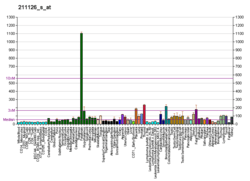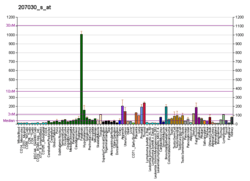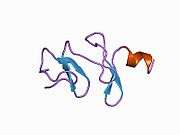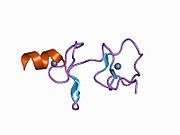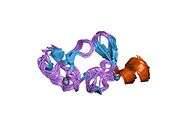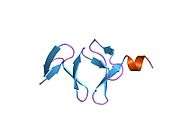CSRP2
Cysteine and glycine-rich protein 2 is a protein that in humans is encoded by the CSRP2 gene.[4][5][6]
| CSRP2 | |||||||||||||||||||||||||
|---|---|---|---|---|---|---|---|---|---|---|---|---|---|---|---|---|---|---|---|---|---|---|---|---|---|
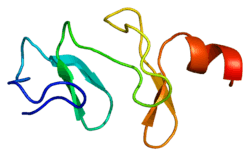 | |||||||||||||||||||||||||
| |||||||||||||||||||||||||
| Identifiers | |||||||||||||||||||||||||
| Aliases | CSRP2, CRP2, LMO5, SmLIM, cysteine and glycine rich protein 2 | ||||||||||||||||||||||||
| External IDs | OMIM: 601871 MGI: 1202907 HomoloGene: 111061 GeneCards: CSRP2 | ||||||||||||||||||||||||
| |||||||||||||||||||||||||
| |||||||||||||||||||||||||
| |||||||||||||||||||||||||
| Orthologs | |||||||||||||||||||||||||
| Species | Human | Mouse | |||||||||||||||||||||||
| Entrez | |||||||||||||||||||||||||
| Ensembl |
| ||||||||||||||||||||||||
| UniProt | |||||||||||||||||||||||||
| RefSeq (mRNA) | |||||||||||||||||||||||||
| RefSeq (protein) | |||||||||||||||||||||||||
| Location (UCSC) | Chr 12: 76.86 – 76.88 Mb | n/a | |||||||||||||||||||||||
| PubMed search | [2] | [3] | |||||||||||||||||||||||
| Wikidata | |||||||||||||||||||||||||
| |||||||||||||||||||||||||
CSRP2 is a member of the CSRP family of genes, encoding a group of LIM domain proteins, which may be involved in regulatory processes important for development and cellular differentiation. CRP2 contains two copies of the cysteine-rich amino acid sequence motif (LIM) with putative zinc-binding activity, and may be involved in regulating ordered cell growth. Other genes in the family include CSRP1 and CSRP3.[6]
References
- GRCh38: Ensembl release 89: ENSG00000175183 - Ensembl, May 2017
- "Human PubMed Reference:". National Center for Biotechnology Information, U.S. National Library of Medicine.
- "Mouse PubMed Reference:". National Center for Biotechnology Information, U.S. National Library of Medicine.
- Weiskirchen R, Pino JD, Macalma T, Bister K, Beckerle MC (Jan 1996). "The cysteine-rich protein family of highly related LIM domain proteins". J Biol Chem. 270 (48): 28946–54. doi:10.1074/jbc.270.48.28946. PMID 7499425.
- Weiskirchen R, Erdel M, Utermann G, Bister K (Nov 1997). "Cloning, structural analysis, and chromosomal localization of the human CSRP2 gene encoding the LIM domain protein CRP2". Genomics. 44 (1): 83–93. doi:10.1006/geno.1997.4855. PMID 9286703.
- "Entrez Gene: CSRP2 cysteine and glycine-rich protein 2".
External links
- Human CSRP2 genome location and CSRP2 gene details page in the UCSC Genome Browser.
Further reading
- Jain MK, Fujita KP, Hsieh CM, et al. (1996). "Molecular cloning and characterization of SmLIM, a developmentally regulated LIM protein preferentially expressed in aortic smooth muscle cells". J. Biol. Chem. 271 (17): 10194–9. doi:10.1074/jbc.271.17.10194. PMID 8626582.
- Karim MA, Ohta K, Egashira M, et al. (1997). "Human ESP1/CRP2, a member of the LIM domain protein family: characterization of the cDNA and assignment of the gene locus to chromosome 14q32.3". Genomics. 31 (2): 167–76. doi:10.1006/geno.1996.0028. PMID 8824798.
- Weiskirchen R, Gressner AM (2000). "The cysteine- and glycine-rich LIM domain protein CRP2 specifically interacts with a novel human protein (CRP2BP)". Biochem. Biophys. Res. Commun. 274 (3): 655–63. doi:10.1006/bbrc.2000.3187. PMID 10924333.
- Weiskirchen R, Moser M, Weiskirchen S, et al. (2001). "LIM-domain protein cysteine- and glycine-rich protein 2 (CRP2) is a novel marker of hepatic stellate cells and binding partner of the protein inhibitor of activated STAT1". Biochem. J. 359 (Pt 3): 485–96. doi:10.1042/0264-6021:3590485. PMC 1222169. PMID 11672422.
- Strausberg RL, Feingold EA, Grouse LH, et al. (2003). "Generation and initial analysis of more than 15,000 full-length human and mouse cDNA sequences". Proc. Natl. Acad. Sci. U.S.A. 99 (26): 16899–903. doi:10.1073/pnas.242603899. PMC 139241. PMID 12477932.
- Wang M, Hu Y, Shima I, Stearns ME (2003). "IL-10/IL-10 receptor signaling regulates TIMP-1 expression in primary human prostate tumor lines". Cancer Biol. Ther. 1 (5): 556–63. doi:10.4161/cbt.1.5.222. PMID 12496489.
- Stearns ME, Wang M, Hu Y, Garcia FU (2004). "Interleukin-10 activation of the interleukin-10E1 pathway and tissue inhibitor of metalloproteinase-1 expression is enhanced by proteasome inhibitors in primary prostate tumor lines". Mol. Cancer Res. 1 (9): 631–42. PMID 12861049.
- Gerhard DS, Wagner L, Feingold EA, et al. (2004). "The Status, Quality, and Expansion of the NIH Full-Length cDNA Project: The Mammalian Gene Collection (MGC)". Genome Res. 14 (10B): 2121–7. doi:10.1101/gr.2596504. PMC 528928. PMID 15489334.
This article is issued from Wikipedia. The text is licensed under Creative Commons - Attribution - Sharealike. Additional terms may apply for the media files.


